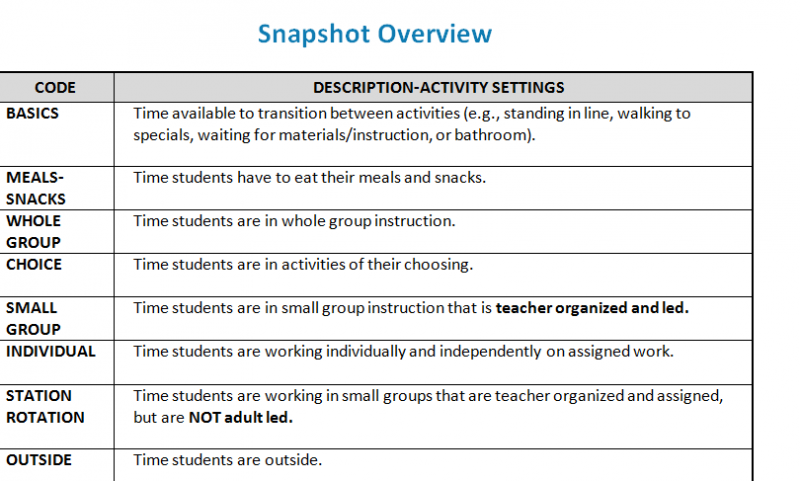USING DATA TO CREATE A CULTURE OF COLLABORATIVE INQUIRY
 Teachers and schools are often buried in data, and may feel that they already receive too much information about their students' progress. Unfortunately, with little time allocated to reflect on how data might inform adjustments to curriculum and instruction, its potential to drive improvement becomes limited. However, we have seen FirstSchool partners more effectively collect, interpret, and then utilize data to better serve their students. These experiences have provided us with some suggestions for structuring collaborative inquiry that asks teachers to 1) analyze a typical day in their classroom, 2) consider a wide variety of relevant sources that might inform next steps, and 3) connect their own professional learning to concrete action. We believe that while the effective use of data is at the center of improving school for African American, Latino, and low-income students, teachers need more guidance in this area.
Teachers and schools are often buried in data, and may feel that they already receive too much information about their students' progress. Unfortunately, with little time allocated to reflect on how data might inform adjustments to curriculum and instruction, its potential to drive improvement becomes limited. However, we have seen FirstSchool partners more effectively collect, interpret, and then utilize data to better serve their students. These experiences have provided us with some suggestions for structuring collaborative inquiry that asks teachers to 1) analyze a typical day in their classroom, 2) consider a wide variety of relevant sources that might inform next steps, and 3) connect their own professional learning to concrete action. We believe that while the effective use of data is at the center of improving school for African American, Latino, and low-income students, teachers need more guidance in this area.
Making a shift towards a more productive, positive culture of collaborative inquiry means using data to drive continuous improvement in ways that are more formative than evaluative. If teachers trust that data will be used as a tool for growth, rather than as a tool for judgment, they will be more likely to honestly share their challenges with others and problem-solve together.
Click here to access a video of Dr. Sharon Ritchie, Director of FirstSchool, discussing this mindset towards more effectively utilizing data to promote growth and professional development.
Click here to access a video of Laura Gutmann, Research Assistant, further discussing how to create school environments that better support using data as a tool for instructional decision making, reflection, and growth.
The following resources include tools for teachers, grade levels, and schools to determine where they are currently at in terms of developing a culture of collaborative inquiry within their own context. They also provide direction in moving forward, and describe what those conversations and processes might look like.
For example, teachers might examine one aspect of their practice, such as how much time students in their school typically spend in various instructional formats or activity settings, such as small or whole-group instruction. The graph to the right provides a glance at that type of summary data, which FirstSchool collected using a tool we designed called the Snapshot.
However, there are a variety of tools available to help teachers more closely examine their practice. It is important to involve teachers in determining what they want to examine, how they will gather relevant data, and how they will analyze and interpret that information once it is collected. Then, time should also be allocated for further reflection and potential adjustments after initial implementation, as part of a continuous, cylical process.
Resources Related to Use of Data:
 A FirstSchool Cornerstone: Examining Relevant Data
A FirstSchool Cornerstone: Examining Relevant Data
An overview of FirstSchool's approach to using data within a culture of collaborative inquiry - and a great starting point for those looking to instill this type of process within their own educational settings!
For those of you who want to learn more about what the Snapshot measure examines, or for educators who have already received Snapshot data about their classrooms, this overview serves as a glossary of sorts that describes the types of teaching and learning activities, settings, content, behaviors, and interactions that Snapshot focuses on.
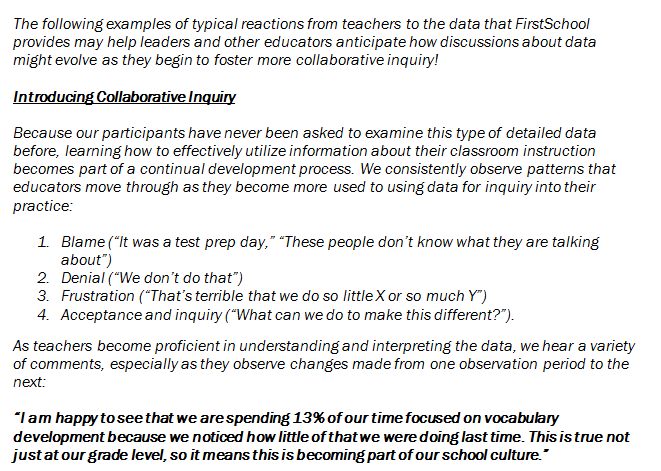 Introducing Collaborative Inquiry
Introducing Collaborative Inquiry
Some examples of typical reactions from teachers as they begin to contribute to developing a culture of collaborative inquiry and examine their growth within the classroom. For more information, we also encourage you to check out the chapter on collaborative inquiry & effectively utilizing data within our new book about the FirstSchool approach!
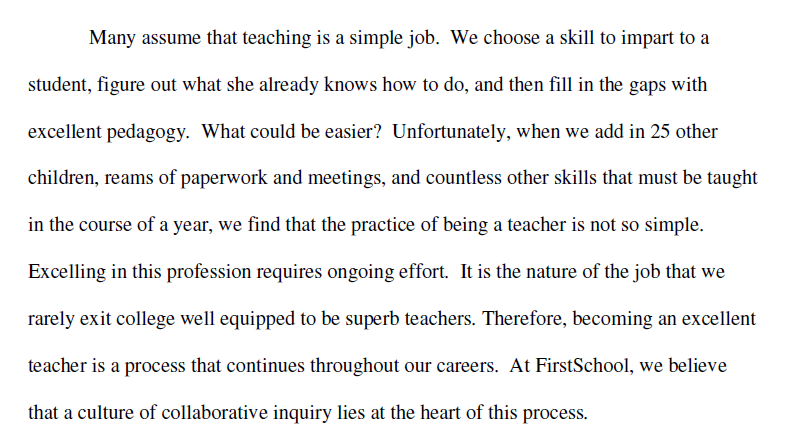 Introductory Guidance for Using our Rubrics to Gauge Your School's Culture of Collaborative Inquiry
Introductory Guidance for Using our Rubrics to Gauge Your School's Culture of Collaborative Inquiry
Before using the rubrics listed below, we encourage you to read these introductory guidelines that explain how the rubrics were constructed and how you might use them within your own educational setting.
 Rubric to Guide Discussion of Your School's Culture of Collaborative Inquiry
Rubric to Guide Discussion of Your School's Culture of Collaborative Inquiry
This rubric provides specific examples of the key aspects of a strong culture of collaborative inquiry. It is intended to guide discussion as school practitioners determine whether they are beginning, developing, operational, or exemplary in each ot these areas. Please note that this rubric can help identify both areas of strength and growth opportunities.
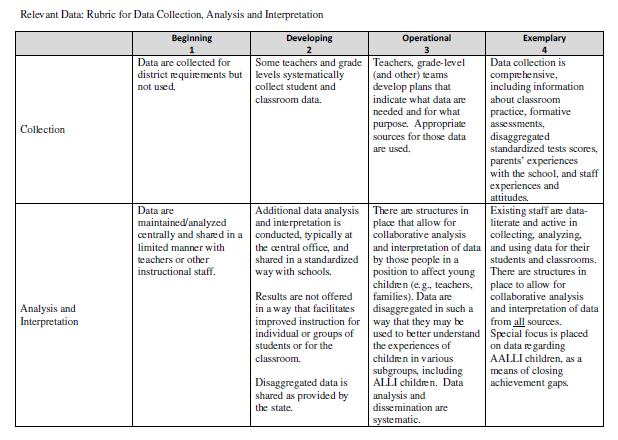 Rubric to Guide Discussion of Your School's Data Collection, Analysis and Interpretation
Rubric to Guide Discussion of Your School's Data Collection, Analysis and Interpretation
This rubric provides specific examples of areas that school personnel should consider as they build their proficiency in collecting, analyzing, and interpreting data (that they either already have or want to gather). As with the rubric above, it is intended to guide discussion as practitioners talk together to determine whether they are beginning, developing, operational, or exemplary in each of these areas. Please note that this rubric can help identify both areas of strength and growth opportunities.
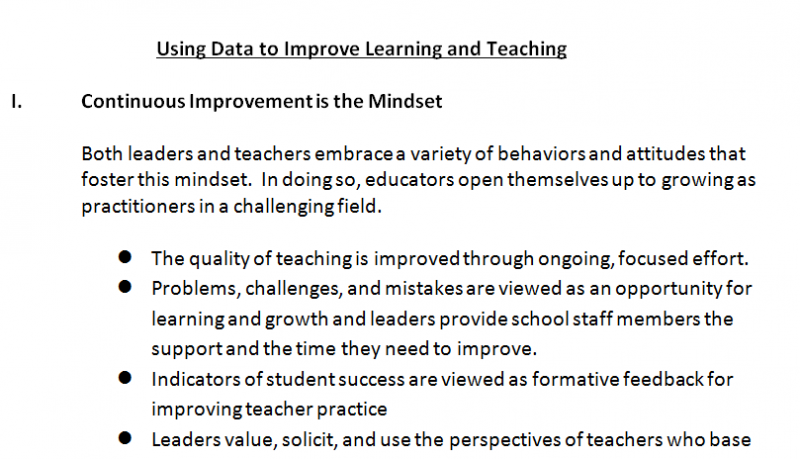 Tips for Discussing Data with Educators & Using it to Improve Learning & Teaching
Tips for Discussing Data with Educators & Using it to Improve Learning & Teaching
Dr. Sharon Ritchie created these suggestions for discussing data with teachers and other educators based on her experiences working with FirstSchool partners in the field. This go-to handout will provide you with a quick overview of her approach to creating a culture of collaborative inquiry.



